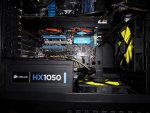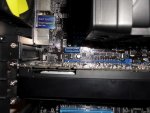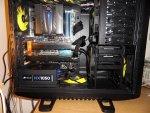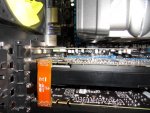tom_gr7
Life Serving
Hey everyone,
Though I'd post a thread explaining the basics of pci and pci-e slots. There is little difference if any in performance between the pci and pci-e, however, installation and placing can effect other components. I think its important to plan ahead when creating ya dream rig, although PCS will install components in the best suited slots, however, when adding two gpu's and two pci/pci-e devices you may have a few minor problems. I will explain where each slot is.
If you look at this picture below, its a p7z77 v motherboard, it supports both sli and crossfire.
I have circled the different slots,

- the two slots circled in blue are what ya gpu/gpu's will be connected in/plugged in.
- the two slots circled in green are the PCI slots, can be either a soundcard or a network card, or perhaps other devices.
- the two slots circled in red are PCI-E slots, again can be either a soundcard or a network card, again other devices too.
- The black slot at the bottom, can be used too for adding another gpu, however, this is not really needed, also you will need a massive case, with very good cooling!
Most new high end graphics cards are normally dual slot now days, (apart from low end gpu's) so that means the card chosen most likely cover two slots on the motherboard, always the slot below. soundcard/network cards are usually single slot cards, however, the positioning can effect other devices.
So if for instance we installed a gpu on this motherboard.
The gpu would be installed into the highest pci slot, (in blue circle) it will also block the pci-e slot below it (circled in red)you can't see the blocked slot, but we know its there. You can just about make out the pci slot (green) right below the gpu, this slot can still be used, but may block one of the fans on the gpu, depending on the model of gpu. (some gpu's have dual fans, some have a single fan) So in this circumstance we have two spare PCI slots (green), and one spare PCI-E slot (red) above the gpu. As well as another slot to add another GPU (blue), This can be seen on this pic below (my rig different mobo, but the same layout)

We can see the PCI-E (red) slot that is still available see the picture below

We also have slot for a gpu, however, if we added a another gpu it would again block the PCI slot below. Therefore now we only have one PCI slot free, however, its right under the top GPU, so not an ideal place, (NOTE it could still be used) Or the black slot right at the bottom, (may be hard to make out) not a ideal place to slot a card either. So if we added another GPU to the rig, it would now look like this, See pic below,

We do have a PCI-E slot above the gpu's that can be used without effecting the gpu' at all. Such as a sound card or a network card,
Such as a sound card or a network card,
See the picture below where I have added a soundcard.

I hope this help people understand how PCI and PCI-E slots effect a Rig,
Though I'd post a thread explaining the basics of pci and pci-e slots. There is little difference if any in performance between the pci and pci-e, however, installation and placing can effect other components. I think its important to plan ahead when creating ya dream rig, although PCS will install components in the best suited slots, however, when adding two gpu's and two pci/pci-e devices you may have a few minor problems. I will explain where each slot is.
If you look at this picture below, its a p7z77 v motherboard, it supports both sli and crossfire.
I have circled the different slots,

- the two slots circled in blue are what ya gpu/gpu's will be connected in/plugged in.
- the two slots circled in green are the PCI slots, can be either a soundcard or a network card, or perhaps other devices.
- the two slots circled in red are PCI-E slots, again can be either a soundcard or a network card, again other devices too.
- The black slot at the bottom, can be used too for adding another gpu, however, this is not really needed, also you will need a massive case, with very good cooling!
Most new high end graphics cards are normally dual slot now days, (apart from low end gpu's) so that means the card chosen most likely cover two slots on the motherboard, always the slot below. soundcard/network cards are usually single slot cards, however, the positioning can effect other devices.
So if for instance we installed a gpu on this motherboard.
The gpu would be installed into the highest pci slot, (in blue circle) it will also block the pci-e slot below it (circled in red)you can't see the blocked slot, but we know its there. You can just about make out the pci slot (green) right below the gpu, this slot can still be used, but may block one of the fans on the gpu, depending on the model of gpu. (some gpu's have dual fans, some have a single fan) So in this circumstance we have two spare PCI slots (green), and one spare PCI-E slot (red) above the gpu. As well as another slot to add another GPU (blue), This can be seen on this pic below (my rig different mobo, but the same layout)

We can see the PCI-E (red) slot that is still available see the picture below

We also have slot for a gpu, however, if we added a another gpu it would again block the PCI slot below. Therefore now we only have one PCI slot free, however, its right under the top GPU, so not an ideal place, (NOTE it could still be used) Or the black slot right at the bottom, (may be hard to make out) not a ideal place to slot a card either. So if we added another GPU to the rig, it would now look like this, See pic below,

We do have a PCI-E slot above the gpu's that can be used without effecting the gpu' at all.
See the picture below where I have added a soundcard.

I hope this help people understand how PCI and PCI-E slots effect a Rig,
Last edited:


